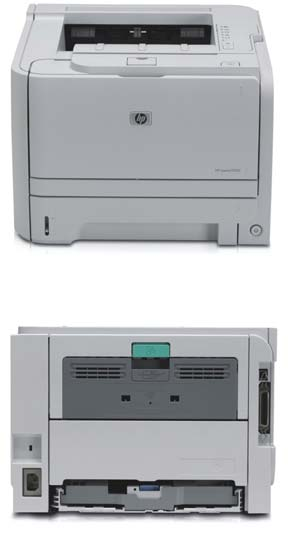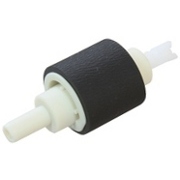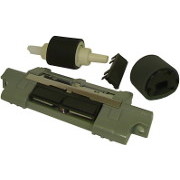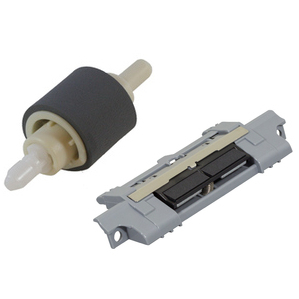
HP RM1-6414 Tray 2 Pickup Roller for P2035 and P2055 Printers.
HP part RM1-6414-000CN is the pickup roller for the cassette tray in LaserJet P2035 and P2055 printers. It is a D shaped roller which turns once to push paper out of the cassette tray to the point where it can be gripped by the feed rollers.

Parts Use
The same roller is used in the P2035 and P2055; they are based on the same engine
. The P2055 has more features: an LCD control panel, more memory and can take an extra 500 sheet "tray 3" giving the ability to handle two or three different kinds of paper (or simply more paper). The P2055 can also take a larger CE505X cartridge giving more economical printing. However, parts are essentially the same.
The LaserJet Pro M401 series is clearly based on the same chassis and roller RM1-9168 is probably the same thing as RM1-6414. In 2013 no demand has yet materialised.
The same roller is also used in the Canon MF6600. Crossover between manufacturers is no surprise, Canon and HP have worked together on printers for well over twenty years now with most HP printers being made from engines that originate with Canon. HP Codes that begin "RM" and end "-000CN" suggest the parts are made by Canon.
Alternate Roller Codes
In this case two identical pickup rollers with different part numbers are used for the P2055. HP Part RM1-6414-000CN is the pickup roller for the paper cassette tray in both the P2035 and P2055. For some reason the part number given for P2055 tray 3 (CE464A) is RM1-6467-000CN. We have found no difference between RM1-6414 and RM1-6467; they look the same in every respect. Potentially they could be different, tray 2 just takes 250 sheets whilst tray 3 takes 500 sheets. The rollers seem the same: they look identical, have the same dimensions and weigh the same. They can be different prices in distribution but that seems to be just about the only practical difference.
Detailed Description

The RM1-6414 roller is grey or grey-black rubber about an inch in diameter and an inch wide (accurate measurements below). It is a "D" roller, although in this case one side is just a bit flattened; nevertheless it will disengage from the paper. (The rubber jacket on a roller with one side completely flat would either have to be under tension or would need some arrangement to secure it.)
The rubber surface carries a texture. It is something like crepe paper, the flesh on the back of a hand or ripples on sand when the tide goes out. The roller is not completely symmetric; one side of the "D" shaped flattening is slightly concave, the other convex. Since the paper isn't in contact with the paper at this point this asymmetry is a mystery. The core is white plastic (cream) and includes an axle or shaft that protrudes an inch or so at either side. One side of the roller shaft is spring-loaded, pressing the shaft inwards disengages it from the printer drive shaft so that it can easily be removed and replaced.

RM1-6414 is quite like RL1-0540-000 (RL1-0542 / RB2-2891 etc) used in the older LaserJet 1160 / 1320 / 2100 / 2200 / 2300/ 2420 / P2015 etc. The advantage is that the new roller's spring loaded axle should make removal and insertion of a new roller even easier. The dimension of the roller itself are very similar, but the axles of the new roller are a bit shorter.

Idle Rollers
In use the roller is usually paired with a couple of circular idle rollers that mount on the shoulders at the side (see below). Where some idle rollers are straight-forward solid nylon these have ridged rubber tyres on them. The idle rollers keep the paper flat whilst the pickup roller propels it. The rounded part of the roller has a circumference of approximately 54mm so that will be how far it thrusts the paper before engaging the feed rollers.
Roller Wear
All pickup rollers have one common issue, the surface texture wears away and without it the pickup roller can't move the paper adequately. Almost all printers use a soft rubber (a butyl mix) which is prone to this when the printer has handled many thousand pages. For some printers we see a life for the rollers of 200,000 pages cited, but that seems rather more than experience suggests. It obviously does depend on composition of the rubber, volatility of softeners and the nature of the paper itself.
Roller Faults
Paper feed faults are most commonly : wrong paper, damp paper or bad paper guide settings. If none of those things is to blame then suspect wear on the rollers. They will tend to have a first occurrence which might be put down to paper quality and might indeed be caused by that. Then the problems will recur more often as the roller decays. In printers like these where the roller works against a separation pad things will tend to worsen quite quickly; when the paper feed fails the roller grinds against the separation pad making an unpleasant noise and grinding its texture away. At first it may feed but fall short so that there is paper in the throat of the printer. After a growing number of misfeeds the roller probably won't be able to get a sheet of paper over the separation pad.
These rollers feed paper from tray 2, the cassette that pushes in under the printer. If the tray gives persistent misfeeds then try feeding from the drop-down multipurpose tray 1. If that works reliably whilst tray 2 does not then there is a very high chance the problem lies with the pickup roller. Other possibilities are mis-adjustment of the tray paper guides, bad feed rollers or the tray-2 clutch. Basically, if the tray 2 rollers look worn and have very little texture then they are the problem. Buy a paper feed repair kit and it will solve the problem. They are available here.
Changing the Roller
The roller fits into some bushings (bearings) on the underside of the printer. The task is quite easy but not so simple as on some of the larger printers like the LaserJet 4200 or M601. For some reason low cost printers aren't quite so easy to repair.
The printer needs to be unplugged and disconnected from the computer before you work on it. Disconnect the power for your safety and so the printer can't in any way start up whilst you work on it. Disconnect the data lead so it doesn't get strained.
The pickup roller is in the bottom front of the printer just above the cassette. The easiest way to get at it is probably to turn the printer on its side but before doing that it may be a good idea to take the cartridge out just in case you have one of those refurbs that is a little prone to dribbling. Printers that need their rollers changing could often do with an internal clean as well.
Take the paper cassette out and put it aside. Turn the printer on its side or back depending on your preferred work position. Be careful not to overstress any of the plastics.
The roller is visible in the front middle of the base of the printer. It may not be self evident how it is released.
The first step in removing the roller is to rotate plastic bushings on both sides of it. The bushings are white nylon, with a locking tab moulded on. Rotate the locking tab towards the inside of the printer and half-cups in the bushings move into the open position. The roller still doesn't lift straight out, it needs to be pushed to the printer left until it disengages from the drive shaft, then it can be pulled out right side first.
A feed roller might push multiple sheets of paper out of the tray. Multiple paper feed is prevented by the separation pad which is located in the cassette tray. The pad (RM1-6397) is held by two screws. The new pad simply screws in when the old is removed.
It is normal to replace the pad at the same time as the roller. They rub together and tend to wear out at around the same rate, and it can be difficult to tell which specifically is the cause of a problem.
Remedies and Repairs
If you have a printer that is playing up you might want to confirm the problem before spending money on spares. Printer pickup and feed rollers can't be repaired, although their defects can sometimes be remedied. Rollers go wrong in two ways:
- Gathering dust and deposits from the paper so that the texture is obscured. Problems will be reduced by cleaning the rollers with a damp lint-free cloth. Strong solvents aren't recommended; for instance isopropyl alcohol might dissolve the softeners in the butyl rubber so that whilst it might work at first performance rapidly decays. Printer manufacturers even suggest skin-oils are capable of denaturing rollers.
- Wearing out the texture so that it no longer functions. The texture on the roller catches at the flock of the paper surface and flattens so that it grips. Nothing simple will get the texture back. Rotating the rubber a bit will move less worn material to the more active part of the surface and get a bit more life from the roller. Of course the roller tyre is not intended for this so whilst experience suggests it can work there are no guarantees.
The solution to paper feed problems is new rollers and a paper feed kit provides that economically.
Counterfeit Rollers
There are such things as "counterfeit rollers". So far as we can tell most aren't made to be counterfeit but as "compatibles". There are a surprising number of manufacturers for some items, there seem to be at least 40 Chinese outfits who claim to be making parts for HP but most names aren't found in the annual "HP Suppliers" list.
There is a dichotomy with the RM1-6414 / RM1-6467; it is used by both Canon and HP. We think the original is made by Canon because that fits the known relationship between the two. It is unlikely that there is any formulation difference between HP and Canon parts, why would Canon (or HP) use an inferior product. At the moment (October 2013) Canon's prices are substantially lower than HPs so we think it is fair to use them and pass the advantage on.
We are sceptical of other "compatibles". There is a legitimate place for compatible parts. We sell compatible parts for things like the LaserJet 4 where there are no originals to be had - it was last made in 1993 and HP/ Canon withdrew the spares years ago. The principles used by older printers are well known, patents on the intellectual property have probably expired and it should be possible to make a copy that really does equal or exceed manufacturers original parts.
Compatibles help the market even if, like us, you generally avoid them. Alternative supplies exert a competitive pressure on manufacturers not to exploit their spares monopoly too hard. Some manufacturers are quite aggressive or even unprincipled in spares pricing; HP are quite good.
Problems comes when distributors silently substitute compatibles made by ‘Perfect Parts’ and ‘Microspareparts’ or one of the Chinese vendors for parts made by Canon or HP.
We source RM1-6414 and RM1-6467 as Canon or HP. However there is potentially a problem, even then. Parts and boxes are not badged in any way. Where HP will have their logo all over the box for something expensive like a print cartridge or maintenance kit, they don't do that with rollers. Neither the roller or the box are marked HP or Canon; they simply come in boxes that we recognise as being "Canon style". We do check, we try to maintain records of how things look and we source parts from authorised distributors. On occasions when distributors try silent substitution on us we return the offending article.
There is a deeper problem here. Many of the parts used by the printer industry are made by contract manufacturers in China and Vietnam. We know the RM1-6414 is also known as RM1-6467 and sold at a higher price under that name. We know the roller fits a Canon MP6600 and relations. We don't know whether the same roller appears with a completely different product code in other printers - it would make sense if it did. Sometimes it is self-evident who made the part, motors are often labelled Nidek and power supplies Delta or Aztec. Rollers generally aren't labelled. And if HP/Canon do sometimes order parts from the companies who claim they are making them - perhaps indirectly - then that company is actually the original manufacturer. That can't be taken on trust, however.
Look at it another way. If people were intentionally making counterfeits they could make the packing as easily as the roller. If you buy containerloads of items (at a high price) direct from the brand name that gives their assurance of quality there still remains the possibility that they switched sub-contractor and quality suffered. We think the only reliable way to spot rogue parts is to look at batches of an item in some detail, that is what we do openly here. Industry talk suggests the same thing although most vendors like to keep their comments simple (if misleading). We aim for openness.
Associated Parts
The roller works against:
- pad RM1-6397 in the P2035/P2055 250 sheet tray 2.
- and against pad RM1-6454 in the P2055 500 sheet tray 3.
The idle roller part number is not given in the service manual. A bit of Web research didn't reveal the part number. So far as we know replacement is rare.
The pickup roller gear (used in the P2014/P2015 and P2025/P2055) is RM1-4275.
RK2-2729 is Solenoid SL2 -The paper pick-up roller solenoid for tray 2.
Other parts include the bushing/ clips that secure the roller. HP do not seem to have assigned a part number so they are not officially available. We have been asked for this part but when we asked around a broker wanted £25 and the potential customer was displeased about being asked to pay £30. We agree with him, but brokers don't part with things lightly. Selling those parts means a printer chassis goes in the skip. The customer will have to glue the parts in - or find someone prepared to give him the clips.
Extreme Detail
One way to determine if two things are the same is to measure them. Digital calliper measurements of the RM1-6414, RM1-6467 and a couple of related rollers follow.
| Roller | RM1-6414 | RM1-6467 | RL1-3167 | RL1-0542 |
|---|---|---|---|---|
| D-roller widest | 30.00mm | 30.97 | 31.00 | 30.9 |
| Core at widest | 26.91 | 26.91 | 26.96 | 26.79 |
| D-roller narrowest | 27.59 | 27.4 | 27.4 | 27.37 |
| Core narrowest | 23.9 | 23.8 | 23.96 | 23.48 |
| Rubber width | 26.32 | 26.30 | 26.25 | 25.85 |
| Core width | 29.00 | 28.94 | 28.96 | 28.79 |
| Total Length | 79.25 | 79.36 | 70.00 | 86.60 |
| Core main moulding | 62.79 | 62.91 | 48.38 | - |
| Weight | 21gm | 21gm | - | - |
| Weight Packed | 31gm | 31gm | - | - |
Table dimensions are in millimetres, weights in grammes.
To see CE483A in context in the engineering diagrams click here.
HP Information
A query to Partsurfer for RM1-6414-000CN
(131026):
RM1-6414-000CN Paper pickup roller assembly - For the LaserJet P2035/P2055 printer series.
HP LASERJET P2035 PRINTER
HP LASERJET P2035N PRINTER
HP LASERJET P2055D PRINTER
HP LASERJET P2055DN PRINTER
HP LASERJET P2055X PRINTER
HP LaserJet P2055 Printer
A query to Partsurfer for RM1-6467-000CN
(131026):
RM1-6467-000CN 500 sheet tray paper pickup roller assembly - Wide gray rubber roller with serrated rollers on each side of it
HP LASERJET P2035 PRINTER (?)
HP LASERJET P2035N PRINTER (?)
HP LASERJET P2055X PRINTER
HP LaserJet P2055 Printer
We have marked the first two lines with question marks because the 500 sheet tray in not used on the P2035 - although the roller will also fit the 250 sheet tray.
Icecat shows RM1-6414-000CN with EAN/UPC code 5704327580959
. There had been 37 product views on this part
Icecat shows RM1-6467-000CN as " 500 sheet tray paper pickup roller assembly - Wide gray rubber roller with serrated rollers on each side of it " and gives an EAN/UPC code of 5704327983477
with 103 product views.
As already stated the rollers RM1-6414 and RM1-6467 seem identical.
This specific design of roller is used only in the P2035 and P2055 printers and in the CE464A (CE464-69001) Tray 3 used with the P2055.
| RM1-6414-000CN | RM1-6467-000CN | |
| Right Angle View |  |  |
| Mid View |  |  |
| Left Angle View |  |  |


In the last two pictures parts supplied as RM1-6414 in its grey-rubber variant is on the left and RM1-6467 on the right. No mechanical distinction seems evident.
Web Research
The query used was "RM1-6414"
in quotes:
Amazon £6.18, Partshere $17.85, Precision Roller $15.95 (has compat chart), consumablesdepot £19.90, RM-International $0.80 (but the pic is clearly a clone), PartSmart $2.93 (Chinese made),SuppliesShop(consumablesdepot in drag) £19.90, Shenzen DHL Technology offering to sell in quantities 30+, eBay offering the same thing over and over for £28.98.
Prices noted are for a new item without tax. The list is as encountered. We haven't bothered with currency conversion - half of our readers are outside the UK and are more interested in dollar prices. None of the sites examined so far offer much by way of information.
Supply Situation
Rollers for HP printers are usually made by Canon and that seems the case here. Demand for this part has attracted compatible makers producing parts for low prices - selling for as little as $0.80 . At present we have no faith is such parts. On the other hand there seems no point in choosing to sell HP over Canon - they seem identical.
Refurbished parts are worthless. Whilst these parts may be available as "good pulls" from scrap printers we would have little faith in a vendors ability to give any meaningful test, so we don't currently sell them.
The part is listed by five UK distributors, holding stock in fairly small quantities, although one in Europe had 679 . We think demand for the part will be continual but never very substantial whilst the printer remains viable. The printer is likely to remain viable for some years - its successor the LaserJet Pro 400 M401 has black styling but is internally very similar.
This part is normally supplied from our local stock when required. The price is about £6.35 - it changes on a daily basis as the prices in distribution change.
These are guidelines, our prices change with distribution lists - see the catalog. Stock numbers indicate there is not much call for the part.
Copyright G & J Huskinson & MindMachine Associates Ltd 2013, 2015, 2016. Some pictures derived from HP User and Service guides. These technical pages do not constitute an offer for sale; just our knowledge at the time of writing. See the catalog. Sales pages on this Web site use cookies to store user information. We also use Google Analytics to track site usage patterns.



